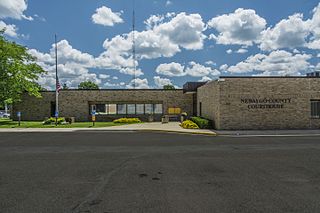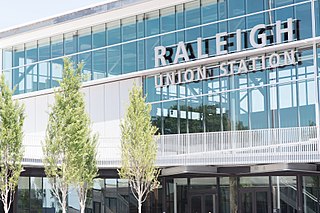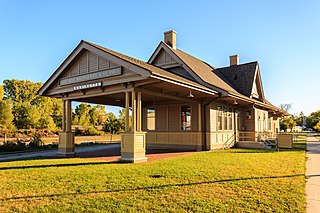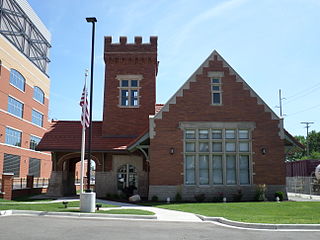
Newaygo County is a county in the U.S. state of Michigan. As of the 2020 United States Census, the population was 49,978. The county seat is White Cloud. The county was created in 1840, and was organized in 1851. It was either named for an Ojibwe leader who signed the Treaty of Saginaw in 1819 or for an Algonquian word meaning "much water".

Grant is a city in Newaygo County in the U.S. state of Michigan. The population was 952 at the 2020 census. The city is adjacent to Grant Township and Ashland Township. It is a part of the Grand Rapids-Muskegon-Holland, Michigan combined statistical area.
Merrill Township is a civil township of Newaygo County in the U.S. state of Michigan. The population was 590 at the 2000 census.

The Monon Railroad, also known as the Chicago, Indianapolis, and Louisville Railway from 1897 to 1971, was an American railroad that operated almost entirely within the state of Indiana. The Monon was merged into the Louisville and Nashville Railroad in 1971, and much of the former Monon right of way is owned today by CSX Transportation. In 1970, it operated 540 miles (870 km) of road on 792 miles (1,275 km) of track; that year it reported 1320 million ton-miles of revenue freight and zero passenger-miles.

The Livingston Avenue Bridge is a railroad bridge over the Hudson River in New York connecting Albany and Rensselaer. The original structure was built in 1866 by the Hudson River Bridge Company but was replaced in 1901–02. A rotating swing bridge span allows large ships to proceed up the river.

The Grand Rapids and Indiana Railroad at its height provided passenger and freight railroad services between Cincinnati, Ohio, and the Straits of Mackinac in Michigan, USA. The company was formed on January 18, 1854.

Michigan Central Station is the historic former main intercity passenger rail station in Detroit, Michigan. Built for the Michigan Central Railroad, it replaced the original depot in downtown Detroit, which was shuttered after a major fire on December 26, 1913, forcing the still unfinished station into early service. Formally dedicated on January 4, 1914, the station remained open for business until the cessation of Amtrak service on January 6, 1988. The station building consists of a train depot and an office tower with thirteen stories, two mezzanine levels, and a roof height of 230 feet. The Beaux-Arts style architecture was designed by architects who had previously worked together on Grand Central Terminal in New York, and it was the tallest rail station in the world at the time of its construction.
Pequaming is an unincorporated community in L'Anse Township of Baraga County in the U.S. state of Michigan. It is located on a narrow point of land that juts into Keweenaw Bay. Although still partially inhabited, Pequaming is one of the largest ghost towns in the Upper Peninsula of Michigan.

The Vernon J. Ehlers Station is a train station in Grand Rapids, Michigan, United States served by Amtrak, the U.S. national railroad passenger system. The station is the terminus of the Pere Marquette line that connects Chicago's Union Station to Grand Rapids. It opened at its new location on Century Avenue under the Wealthy Street/US Highway 131 overpass, immediately south of The Rapid's Central Station. It is named in honor of then-Congressman Vernon J. Ehlers.

The Union Depot is a former train station, located at 637 E. Michigan Avenue in Lansing, Michigan. It was listed on the National Register of Historic Places in 1995. Despite the union name, Grand Trunk Western trains stopped at a different station in Lansing 1.5 miles away.

Raleigh Union Station is an intermodal transit station in Raleigh, North Carolina, United States. Train service began the morning of July 10, 2018. Its main building serves as an Amtrak train station, while a future adjacent building will serve as the bus terminus for GoTriangle. The station is located at the Boylan Wye, a railroad junction used by CSX and Norfolk Southern, and adjacent to the Depot Historic District in downtown Raleigh.

Croton Dam is an earth-filled embankment dam and powerplant complex on the Muskegon River in Croton Township, Newaygo County, Michigan. It was built in 1907 under the direction of William D. Fargo by the Grand Rapids - Muskegon Power Company, a predecessor of Consumers Energy. The 40-foot-high (12 m) dam impounds 7.2 billion U.S. gallons (6 billion imp. gal/27 billion L) of water in its 1,209-acre (489 ha) reservoir and is capable of producing 8,850 kilowatts at peak outflow. It was listed on the National Register of Historic Places in 1979.

The Coopersville Station, built as the Grand Rapids, Grand Haven and Muskegon Railway Depot is a historic railway station once used by the Grand Rapids, Grand Haven and Muskegon Railway in Coopersville, Michigan. The Coopersville Area Historical Society and Museum is now housed in the station.

The Milwaukee Road Depot in Marinette, Wisconsin was built in 1903 by the Chicago, Milwaukee, St. Paul and Pacific Railroad to replace an earlier depot.
The Plymouth Subdivision is a freight railroad line in the U.S. state of Michigan. It is owned by CSX. It connects the Plymouth Diamond at milepost CH 24.5 to Grand Rapids at CH 148.1, passing through the Lansing metropolitan area en route. Other towns served include South Lyon, Brighton, Howell, Fowlerville, Williamston, Grand Ledge, Lake Odessa, Clarksville, and Alto. Operationally, it is part of the CSX Chicago Division, dispatched from Jacksonville, Florida.

The Flint & Pere Marquette Union Station, commonly known as the Potter Street Station, is a former railroad station built in 1881 and used until 1950 located at 501 Potter Street in Saginaw, Michigan, United States. It was designed by New York City architect Bradford Lee Gilbert. The station is 285 feet by 40 feet with 2½ stories.

The Seaboard–All Florida Railway was a subsidiary of the Seaboard Air Line Railroad that oversaw two major extensions of the system in the early 1920s to southern Florida on each coast during the land boom. One line extended the Seaboard's tracks on the east coast from West Palm Beach down to Fort Lauderdale and Miami, while the other extension on the west coast extended the tracks from Fort Ogden south to Fort Myers and Naples, with branches from Fort Myers to LaBelle and Punta Rassa. These two extensions were heavily championed by Seaboard president S. Davies Warfield, and were constructed by Foley Brothers railroad contractors. Both extensions also allowed the Seaboard to better compete with the Florida East Coast Railway and the Atlantic Coast Line Railroad, who already served the lower east and west coasts of Florida respectively.

Lee Hall Depot is a historic train station and museum located in the Lee Hall neighborhood of Newport News, Virginia. It was built in about 1881, with a one-story cargo bay, and the two-story main section was added in 1893. Another one-story wing was added by the Chesapeake and Ohio Railway to the north end of the depot in 1918 to handle an influx of military personnel to Fort Eustis. The building is currently in use as a local history museum, focusing on the station's history, and the history of the Chesapeake & Ohio Railroad in Warwick County.

The Brooksville 1885 Train Depot is one of three museums operated by the Hernando Historical Museum Association. The museum is located just south of downtown Brooksville, Florida on Russell Street. It was originally built by the Florida Southern Railway. The museum is dedicated to the railroad, and local history of Brooksville, Hernando County, and Florida.

The Grand Trunk Western station was a historic railroad station in Lansing, Michigan. The station was listed as a Michigan State Historic Site in 1978, and it was added to the National Register of Historic Places in 1980.


















